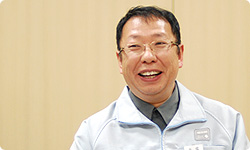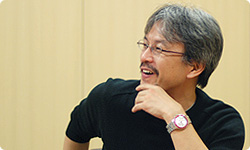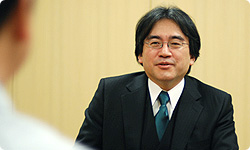2. Kirby and Chomps in Zelda
So you had a hard time with it, but finally finished A Link to the Past. And just when you should have been out of breath, you started developing a game for the Game Boy as a sort of “afterschool club activity.” Why was that?
I can’t really remember that either, but I think it was because there was a lot left over that we still wanted to do. Maybe I felt that way more than anyone else because I had joined development part of the way through, but I had a strong desire to do more.
With a game like Zelda, you may have lots of ideas, but you can never use them all.
That is the Zelda tradition. (laughs)
It began around the time of the Super NES.
I remember that we made Link’s Awakening in a really peculiar frame of mind. We began in the free spirit of an afterschool club, so the contents are quite unrestrained. If you look at it, you can tell. Characters similar to Mario and Luigi
Characters like Mario and Luigi?
Yeah. (laughs)
Was that alright?
It was for the Game Boy, so we thought, “Oh, it’ll be fine.” (laughs)
(laughs)
We couldn’t do much visually anyway.
That’s right. It was monochrome. We moved along at quite a good speed in a relatively freewheeling manner. Maybe that’s why we had so much fun making it. It was like we were making a parody of Zelda.

A parody of your own game? (laughs)
Yeah. (laughs)
Today, if you just barged ahead using characters resembling Mario and Luigi—even if it were for a Nintendo game—it would be quite a problem.
Yeah, I’d get mad. (bluntly)
(laughs)
And it wasn’t just Mario and Luigi, but something like Kirby, too.
Huh?
Oh. (laughs)
But some people at HAL Laboratory might say they never heard anything.
I suppose so. Oh well. I’m not sure how many people at that time recognised it was Kirby.
But that character appeared as one of Link’s enemies, and if you got close, he would suck you up! (laughs)
About that time, Kirby was still just a fledgling character, so I think people thought that it was an honour to have him appear in a Zelda game.
And the Chomps who appear in the Mario games were also enemies. At a certain point in the game you could have them walk along with you.

That’s right! The SRD programmer was doing whatever he wanted and had it so you could hold onto and walk a Chomp
Now just wait a second! Chomps in Zelda?
Yeah. They just appeared like it was normal. And Piranha Plants and Goombas
That certainly is unrestrained. (laughs) You wouldn’t do anything like that today, would you?
No, I doubt it.
If we did, I suppose you’d get mad.
Yeah, I’d get mad. (bluntly)
(laughs)
So, besides Tezuka-san and the SRD team, who worked on Link’s Awakening?
We had (Kensuke) Tanabe-san8 join early on. He thought up the sub-events and stuff like the “Straw Millionaire” parts. 8Kensuke Tanabe: He worked on the scripts for A Link to the Past and Link’s Awakening. Later, he was involved in development of numerous games, such as the Metroid Prime series, Chibi-Robo! and Freshly-Picked Tingle’s Rosy Rupeeland. He is in Nintendo’s Software Planning and Development Division. (Editor's note: "Straw Millionaire" is a term from a Japanese legend. In Zelda games it refers to a trading sequence whereby Link obtains an item of little value that during his journey he trades for another item, and so on, until at the end of the sequence he receives a great reward or unique item.)
Link’s Awakening was the first time for that, right?
Yes. It started then.
Then later on (Yoshiaki) Koizumi-san9 joined. 9Yoshiaki Koizumi: After working on the development of Ocarina of Time and Majora’s Mask, he was involved in the development of 3D Mario games such as Super Mario Sunshine and Super Mario Galaxy, as well as of Nintendo DSiWare such as Flipnote Studio. He is at Nintendo’s Tokyo Software Development Office.
That’s quite an extraordinary team! (laughs)
Koizumi-san had joined the company one or two years earlier and was doing artwork.
He was working with (Yoichi) Kotabe-san10, right? But if he was in a completely different division, then how… 10Yoichi Kotabe: An animator who has worked on animation such as Heidi, Girl of the Alps. After leaving Toei Animation, he joined Nintendo, where he began designing characters such as Mario. Currently he is active as a freelance agent.
It looked like he’d be good at creating a story, so we lured him into our afterschool club.
Really, it would be unthinkable today! (laughs)
Koizumi-san was in charge of the opening movie and main story
What was Miyamoto-san doing at that time?

I think he was busy with something and didn’t pay us much attention.
Oh, just like me this time with Spirit Tracks.
(laughs) I do hear lots of Entertainment Analysis and Development staff members, not just you guys, say he’s busy and doesn’t pay them much mind. “Miyamoto-san’s busy right now and won’t pay us any attention!” At any given time, Miyamoto-san tends to have something that he gives priority above everything else. While he’s absorbed in that, he basically lets everyone else go.
(nods agreement)
Were you able to complete Link’s Awakening without any detours?
Yeah. I don’t remember much in the way of detours at all.
I thought it was a tradition for working on a Zelda title for it to turn into a kind of exercise in suffering.
I remember it was fun working on it, and when it was over, I remember us talking to each other about how fun it was.
Almost like you had awakened from a dream.
Oh, I get it! Like in the game! (laughs)
Some of our readers might want to play Link’s Awakening now. (laughs)
I think it would be fun to play even today.